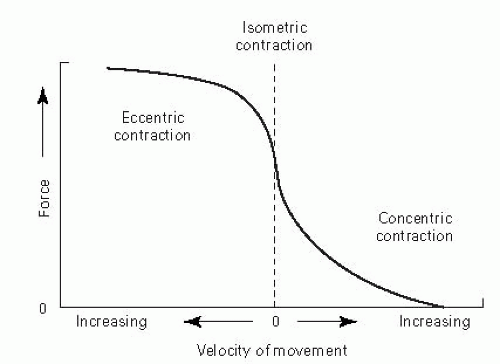Therapeutic Exercise
MUSCLE FIBER CHARACTERISTICS
Type I muscle fibers are “slow-twitch,” highly fatigue-resistant, grossly dark fibers (“dark meat”) that appear light on myosin ATPase (at pH 9.4) or PAS staining. Type II fibers comprise the “white meat” but are dark histologically with these stains (see Table 10-1 for characteristics of each type/subtype).
All fibers in a given motor unit are of the same type. According to the Henneman size principle, smaller motor units are recruited first and then progressively larger units are sequentially recruited as the strength of contraction increases.
STRENGTH TRAINING
Isometric Strengthening – Tension is generated without visible joint motion or appreciable change in muscle length (e.g., pushing against a wall). This is most efficient when the exertion occurs at the resting length of the muscle and most useful when joint motion is contraindicated (e.g., s/p tendon repair) or in the setting of pain or inflammation (e.g., rheumatoid arthritis). Chance of injury is minimized. Isometric exercise should be avoided in the elderly and in patients with HTN due to its tendency to elevate BP.
Isotonic Strengthening – This is characterized by constant external resistance, but variable speed of movement. Examples include free weights,
weight machines (e.g., Nautilus), calisthenics (e.g., pull-ups, push-ups, and sit-ups), and TheraBand. The equipment is readily available, but there is potential for injury with this type of exercise (Fig. 10-1).
weight machines (e.g., Nautilus), calisthenics (e.g., pull-ups, push-ups, and sit-ups), and TheraBand. The equipment is readily available, but there is potential for injury with this type of exercise (Fig. 10-1).
TABLE 10-1 Characteristics of Skeletal Muscle Fiber Subtypes | ||||||||||||||||||||||||||||
|---|---|---|---|---|---|---|---|---|---|---|---|---|---|---|---|---|---|---|---|---|---|---|---|---|---|---|---|---|
|
Isokinetic Strengthening – This is characterized by a relatively constant angular joint speed, but variable external resistance. (Special equipment is required, e.g., Cybex and Biodex.) If the user pushes harder, the speed of the manipulated piece of equipment will not increase, but the resistance supplied by the machine will. This maximizes resistance throughout the length-tension curve of the exercised muscles and is beneficial in the early phases of rehabilitation. The chance of injury is relatively low (Fig. 10-2).
Stay updated, free articles. Join our Telegram channel

Full access? Get Clinical Tree







